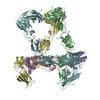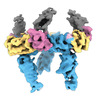[English] 日本語
 Yorodumi
Yorodumi- EMDB-15679: Cryo-EM structure for a 3:3 complex between mouse leptin and the ... -
+ Open data
Open data
- Basic information
Basic information
| Entry |  | |||||||||
|---|---|---|---|---|---|---|---|---|---|---|
| Title | Cryo-EM structure for a 3:3 complex between mouse leptin and the mouse LEP-R ectodomain (local refinement) | |||||||||
 Map data Map data | Sharpened cryo-EM map following non-uniform refinement | |||||||||
 Sample Sample |
| |||||||||
 Keywords Keywords | leptin / LEP-R / obesity / metabolism / energy balance / CYTOKINE | |||||||||
| Function / homology |  Function and homology information Function and homology informationSynthesis, secretion, and deacylation of Ghrelin / regulation of lipoprotein lipid oxidation / cellular response to L-ascorbic acid / positive regulation of fat cell apoptotic process / negative regulation of glutamine transport / leptin receptor activity / regulation of transport / negative regulation of appetite by leptin-mediated signaling pathway / Synthesis, secretion, and inactivation of Glucagon-like Peptide-1 (GLP-1) / negative regulation of glucagon secretion ...Synthesis, secretion, and deacylation of Ghrelin / regulation of lipoprotein lipid oxidation / cellular response to L-ascorbic acid / positive regulation of fat cell apoptotic process / negative regulation of glutamine transport / leptin receptor activity / regulation of transport / negative regulation of appetite by leptin-mediated signaling pathway / Synthesis, secretion, and inactivation of Glucagon-like Peptide-1 (GLP-1) / negative regulation of glucagon secretion / regulation of endothelial cell proliferation / regulation of natural killer cell mediated cytotoxicity / regulation of natural killer cell proliferation / leptin receptor binding / positive regulation of luteinizing hormone secretion / bone growth / regulation of natural killer cell activation / glycerol biosynthetic process / elastin metabolic process / leptin-mediated signaling pathway / positive regulation of hepatic stellate cell activation / positive regulation of follicle-stimulating hormone secretion / regulation of steroid biosynthetic process / positive regulation of monoatomic ion transport / regulation of intestinal cholesterol absorption / regulation of bone remodeling / regulation of brown fat cell differentiation / positive regulation of peroxisome proliferator activated receptor signaling pathway / regulation of nitric-oxide synthase activity / adult feeding behavior / response to leptin / activation of protein kinase C activity / bone mineralization involved in bone maturation / regulation of lipid biosynthetic process / negative regulation of cartilage development / sexual reproduction / regulation of feeding behavior / ovulation from ovarian follicle / negative regulation of appetite / positive regulation of developmental growth / leukocyte tethering or rolling / energy reserve metabolic process / bile acid metabolic process / cellular response to leptin stimulus / prostaglandin secretion / negative regulation of D-glucose import / regulation of protein localization to nucleus / cardiac muscle hypertrophy / hormone metabolic process / positive regulation of p38MAPK cascade / intestinal absorption / regulation of fat cell differentiation / insulin secretion / regulation of metabolic process / aorta development / negative regulation of vasoconstriction / regulation of gluconeogenesis / peptide hormone receptor binding / glycogen metabolic process / eating behavior / fatty acid beta-oxidation / regulation of cytokine production involved in inflammatory response / central nervous system neuron development / response to dietary excess / negative regulation of lipid storage / T cell differentiation / response to vitamin E / cell surface receptor signaling pathway via JAK-STAT / positive regulation of TOR signaling / regulation of angiogenesis / adipose tissue development / negative regulation of gluconeogenesis / phagocytosis / positive regulation of insulin receptor signaling pathway / glial cell proliferation / positive regulation of T cell proliferation / energy homeostasis / cellular response to retinoic acid / positive regulation of interleukin-12 production / regulation of insulin secretion / negative regulation of autophagy / cholesterol metabolic process / response to activity / gluconeogenesis / positive regulation of interleukin-8 production / female pregnancy / positive regulation of receptor signaling pathway via JAK-STAT / determination of adult lifespan / response to insulin / placenta development / hormone activity / regulation of blood pressure / lipid metabolic process / positive regulation of interleukin-6 production / positive regulation of protein import into nucleus / cellular response to insulin stimulus / circadian rhythm / glucose metabolic process / positive regulation of reactive oxygen species metabolic process / positive regulation of tumor necrosis factor production Similarity search - Function | |||||||||
| Biological species |  | |||||||||
| Method | single particle reconstruction / cryo EM / Resolution: 4.42 Å | |||||||||
 Authors Authors | Verstraete K / Savvides SN / Verschueren KG / Tsirigotaki A | |||||||||
| Funding support |  Belgium, 1 items Belgium, 1 items
| |||||||||
 Citation Citation |  Journal: Nat Struct Mol Biol / Year: 2023 Journal: Nat Struct Mol Biol / Year: 2023Title: Mechanism of receptor assembly via the pleiotropic adipokine Leptin. Authors: Alexandra Tsirigotaki / Ann Dansercoer / Koen H G Verschueren / Iva Marković / Christoph Pollmann / Maximillian Hafer / Jan Felix / Catherine Birck / Wouter Van Putte / Dominiek Catteeuw / ...Authors: Alexandra Tsirigotaki / Ann Dansercoer / Koen H G Verschueren / Iva Marković / Christoph Pollmann / Maximillian Hafer / Jan Felix / Catherine Birck / Wouter Van Putte / Dominiek Catteeuw / Jan Tavernier / J Fernando Bazan / Jacob Piehler / Savvas N Savvides / Kenneth Verstraete /     Abstract: The adipokine Leptin activates its receptor LEP-R in the hypothalamus to regulate body weight and exerts additional pleiotropic functions in immunity, fertility and cancer. However, the structure and ...The adipokine Leptin activates its receptor LEP-R in the hypothalamus to regulate body weight and exerts additional pleiotropic functions in immunity, fertility and cancer. However, the structure and mechanism of Leptin-mediated LEP-R assemblies has remained unclear. Intriguingly, the signaling-competent isoform of LEP-R is only lowly abundant amid several inactive short LEP-R isoforms contributing to a mechanistic conundrum. Here we show by X-ray crystallography and cryo-EM that, in contrast to long-standing paradigms, Leptin induces type I cytokine receptor assemblies featuring 3:3 stoichiometry and demonstrate such Leptin-induced trimerization of LEP-R on living cells via single-molecule microscopy. In mediating these assemblies, Leptin undergoes drastic restructuring that activates its site III for binding to the Ig domain of an adjacent LEP-R. These interactions are abolished by mutations linked to obesity. Collectively, our study provides the structural and mechanistic framework for how evolutionarily conserved Leptin:LEP-R assemblies with 3:3 stoichiometry can engage distinct LEP-R isoforms to achieve signaling. | |||||||||
| History |
|
- Structure visualization
Structure visualization
| Supplemental images |
|---|
- Downloads & links
Downloads & links
-EMDB archive
| Map data |  emd_15679.map.gz emd_15679.map.gz | 40.5 MB |  EMDB map data format EMDB map data format | |
|---|---|---|---|---|
| Header (meta data) |  emd-15679-v30.xml emd-15679-v30.xml emd-15679.xml emd-15679.xml | 23.5 KB 23.5 KB | Display Display |  EMDB header EMDB header |
| FSC (resolution estimation) |  emd_15679_fsc.xml emd_15679_fsc.xml | 7.4 KB | Display |  FSC data file FSC data file |
| Images |  emd_15679.png emd_15679.png | 121.2 KB | ||
| Masks |  emd_15679_msk_1.map emd_15679_msk_1.map | 42.9 MB |  Mask map Mask map | |
| Filedesc metadata |  emd-15679.cif.gz emd-15679.cif.gz | 7.2 KB | ||
| Others |  emd_15679_additional_1.map.gz emd_15679_additional_1.map.gz emd_15679_half_map_1.map.gz emd_15679_half_map_1.map.gz emd_15679_half_map_2.map.gz emd_15679_half_map_2.map.gz | 21.6 MB 39.7 MB 39.7 MB | ||
| Archive directory |  http://ftp.pdbj.org/pub/emdb/structures/EMD-15679 http://ftp.pdbj.org/pub/emdb/structures/EMD-15679 ftp://ftp.pdbj.org/pub/emdb/structures/EMD-15679 ftp://ftp.pdbj.org/pub/emdb/structures/EMD-15679 | HTTPS FTP |
-Validation report
| Summary document |  emd_15679_validation.pdf.gz emd_15679_validation.pdf.gz | 955.5 KB | Display |  EMDB validaton report EMDB validaton report |
|---|---|---|---|---|
| Full document |  emd_15679_full_validation.pdf.gz emd_15679_full_validation.pdf.gz | 955.1 KB | Display | |
| Data in XML |  emd_15679_validation.xml.gz emd_15679_validation.xml.gz | 14.8 KB | Display | |
| Data in CIF |  emd_15679_validation.cif.gz emd_15679_validation.cif.gz | 18.9 KB | Display | |
| Arichive directory |  https://ftp.pdbj.org/pub/emdb/validation_reports/EMD-15679 https://ftp.pdbj.org/pub/emdb/validation_reports/EMD-15679 ftp://ftp.pdbj.org/pub/emdb/validation_reports/EMD-15679 ftp://ftp.pdbj.org/pub/emdb/validation_reports/EMD-15679 | HTTPS FTP |
-Related structure data
| Related structure data |  8avdMC  7z3pC  7z3qC  7z3rC  8av2C  8avbC  8avcC  8aveC  8avfC  8avoC  8b7qC M: atomic model generated by this map C: citing same article ( |
|---|---|
| Similar structure data | Similarity search - Function & homology  F&H Search F&H Search |
- Links
Links
| EMDB pages |  EMDB (EBI/PDBe) / EMDB (EBI/PDBe) /  EMDataResource EMDataResource |
|---|---|
| Related items in Molecule of the Month |
- Map
Map
| File |  Download / File: emd_15679.map.gz / Format: CCP4 / Size: 42.9 MB / Type: IMAGE STORED AS FLOATING POINT NUMBER (4 BYTES) Download / File: emd_15679.map.gz / Format: CCP4 / Size: 42.9 MB / Type: IMAGE STORED AS FLOATING POINT NUMBER (4 BYTES) | ||||||||||||||||||||||||||||||||||||
|---|---|---|---|---|---|---|---|---|---|---|---|---|---|---|---|---|---|---|---|---|---|---|---|---|---|---|---|---|---|---|---|---|---|---|---|---|---|
| Annotation | Sharpened cryo-EM map following non-uniform refinement | ||||||||||||||||||||||||||||||||||||
| Projections & slices | Image control
Images are generated by Spider. | ||||||||||||||||||||||||||||||||||||
| Voxel size | X=Y=Z: 1.658 Å | ||||||||||||||||||||||||||||||||||||
| Density |
| ||||||||||||||||||||||||||||||||||||
| Symmetry | Space group: 1 | ||||||||||||||||||||||||||||||||||||
| Details | EMDB XML:
|
-Supplemental data
-Mask #1
| File |  emd_15679_msk_1.map emd_15679_msk_1.map | ||||||||||||
|---|---|---|---|---|---|---|---|---|---|---|---|---|---|
| Projections & Slices |
| ||||||||||||
| Density Histograms |
-Additional map: Non-sharpened cryo-EM map following non-uniform refinement
| File | emd_15679_additional_1.map | ||||||||||||
|---|---|---|---|---|---|---|---|---|---|---|---|---|---|
| Annotation | Non-sharpened cryo-EM map following non-uniform refinement | ||||||||||||
| Projections & Slices |
| ||||||||||||
| Density Histograms |
-Half map: Half map A
| File | emd_15679_half_map_1.map | ||||||||||||
|---|---|---|---|---|---|---|---|---|---|---|---|---|---|
| Annotation | Half map A | ||||||||||||
| Projections & Slices |
| ||||||||||||
| Density Histograms |
-Half map: Half map B
| File | emd_15679_half_map_2.map | ||||||||||||
|---|---|---|---|---|---|---|---|---|---|---|---|---|---|
| Annotation | Half map B | ||||||||||||
| Projections & Slices |
| ||||||||||||
| Density Histograms |
- Sample components
Sample components
-Entire : Stucture of mouse leptin in complex with a trimerized form of the...
| Entire | Name: Stucture of mouse leptin in complex with a trimerized form of the mouse Lep-R extracellular region |
|---|---|
| Components |
|
-Supramolecule #1: Stucture of mouse leptin in complex with a trimerized form of the...
| Supramolecule | Name: Stucture of mouse leptin in complex with a trimerized form of the mouse Lep-R extracellular region type: complex / ID: 1 / Parent: 0 / Macromolecule list: #1-#2 Details: The mLEP-R ectodomain was C-terminally fused to a trimeric GCN4 isoleucine zipper tag and secreted from HEK93 FreeStyle cells and complexed with refolded mouse leptin produced in E.coli. |
|---|---|
| Source (natural) | Organism:  |
| Molecular weight | Theoretical: 444 KDa |
-Macromolecule #1: Leptin
| Macromolecule | Name: Leptin / type: protein_or_peptide / ID: 1 Details: Mouse leptin was produced with an N-terminal His-tag and refolded from inclusion bodies produced in E. coli Number of copies: 3 / Enantiomer: LEVO |
|---|---|
| Source (natural) | Organism:  |
| Molecular weight | Theoretical: 18.873283 KDa |
| Recombinant expression | Organism:  |
| Sequence | String: MGSSHHHHHH PGGPGSENLY FQGGSTGGVP IQKVQDDTKT LIKTIVTRIN DISHTQSVSA KQRVTGLDFI PGLHPILSLS KMDQTLAVY QQVLTSLPSQ NVLQIANDLE NLRDLLHLLA FSKSCSLPQT SGLQKPESLD GVLEASLYST EVVALSRLQG S LQDILQQL DVSPEC UniProtKB: Leptin |
-Macromolecule #2: Leptin receptor
| Macromolecule | Name: Leptin receptor / type: protein_or_peptide / ID: 2 Details: The mLEP-R ectodomain was C-terminally fused to a trimeric GCN4 isoleucine zipper tag and secreted from HEK93 FreeStyle cells and complexed with refolded mouse leptin produced in E.coli. Number of copies: 3 / Enantiomer: LEVO |
|---|---|
| Source (natural) | Organism:  |
| Molecular weight | Theoretical: 97.479391 KDa |
| Recombinant expression | Organism:  Homo sapiens (human) Homo sapiens (human) |
| Sequence | String: LNLAYPISPW KFKLFCGPPN TTDDSFLSPA GAPNNASALK GASEAIVEAK FNSSGIYVPE LSKTVFHCCF GNEQGQNCSA LTDNTEGKT LASVVKASVF RQLGVNWDIE CWMKGDLTLF ICHMEPLPKN PFKNYDSKVH LLYDLPEVID DSPLPPLKDS F QTVQCNCS ...String: LNLAYPISPW KFKLFCGPPN TTDDSFLSPA GAPNNASALK GASEAIVEAK FNSSGIYVPE LSKTVFHCCF GNEQGQNCSA LTDNTEGKT LASVVKASVF RQLGVNWDIE CWMKGDLTLF ICHMEPLPKN PFKNYDSKVH LLYDLPEVID DSPLPPLKDS F QTVQCNCS LRGCECHVPV PRAKLNYALL MYLEITSAGV SFQSPLMSLQ PMLVVKPDPP LGLHMEVTDD GNLKISWDSQ TM APFPLQY QVKYLENSTI VREAAEIVSA TSLLVDSVLP GSSYEVQVRS KRLDGSGVWS DWSSPQVFTT QDVVYFPPKI LTS VGSNAS FHCIYKNENQ IISSKQIVWW RNLAEKIPEI QYSIVSDRVS KVTFSNLKAT RPRGKFTYDA VYCCNEQACH HRYA ELYVI DVNINISCET DGYLTKMTCR WSPSTIQSLV GSTVQLRYHR RSLYCPDSPS IHPTSEPKNC VLQRDGFYEC VFQPI FLLS GYTMWIRINH SLGSLDSPPT CVLPDSVVKP LPPSNVKAEI TVNTGLLKVS WEKPVFPENN LQFQIRYGLS GKEIQW KTH EVFDAKSKSA SLLVSDLCAV YVVQVRCRRL DGLGYWSNWS SPAYTLVMDV KVPMRGPEFW RKMDGDVTKK ERNVTLL WK PLTKNDSLCS VRRYVVKHRT AHNGTWSEDV GNRTNLTFLW TEPAHTVTVL AVNSLGASLV NFNLTFSWPM SKVSAVES L SAYPLSSSCV ILSWTLSPDD YSLLYLVIEW KILNEDDGMK WLRIPSNVKK FYIHDNFIPI EKYQFSLYPV FMEGVGKPK IINGFTKDAI DKQQNDAGST GGSGGSGGSG GSGGSRMKQI EDKIEEILSK IYHIENEIAR IKKLIGER UniProtKB: Leptin receptor |
-Macromolecule #3: NICKEL (II) ION
| Macromolecule | Name: NICKEL (II) ION / type: ligand / ID: 3 / Number of copies: 3 / Formula: NI |
|---|---|
| Molecular weight | Theoretical: 58.693 Da |
| Chemical component information |  ChemComp-NI: |
-Experimental details
-Structure determination
| Method | cryo EM |
|---|---|
 Processing Processing | single particle reconstruction |
| Aggregation state | particle |
- Sample preparation
Sample preparation
| Concentration | 0.3 mg/mL | |||||||||
|---|---|---|---|---|---|---|---|---|---|---|
| Buffer | pH: 7.4 Component:
Details: 20 mM HEPES, 150 mM NaCl, pH 7.4 | |||||||||
| Grid | Model: C-flat-1.2/1.3 / Material: COPPER / Mesh: 300 / Support film - Material: CARBON / Support film - topology: HOLEY / Pretreatment - Type: GLOW DISCHARGE / Pretreatment - Time: 30 sec. / Pretreatment - Atmosphere: AIR | |||||||||
| Vitrification | Cryogen name: ETHANE / Chamber humidity: 99 % / Chamber temperature: 295 K / Instrument: LEICA EM GP | |||||||||
| Details | This sample was monodisperse. |
- Electron microscopy
Electron microscopy
| Microscope | TFS KRIOS |
|---|---|
| Image recording | Film or detector model: GATAN K3 BIOQUANTUM (6k x 4k) / Number grids imaged: 1 / Number real images: 13230 / Average electron dose: 45.0 e/Å2 |
| Electron beam | Acceleration voltage: 300 kV / Electron source:  FIELD EMISSION GUN FIELD EMISSION GUN |
| Electron optics | Illumination mode: FLOOD BEAM / Imaging mode: OTHER / Cs: 2.7 mm / Nominal defocus max: 2.5 µm / Nominal defocus min: 1.2 µm / Nominal magnification: 105000 |
| Experimental equipment |  Model: Titan Krios / Image courtesy: FEI Company |
 Movie
Movie Controller
Controller














 Z (Sec.)
Z (Sec.) Y (Row.)
Y (Row.) X (Col.)
X (Col.)





















































